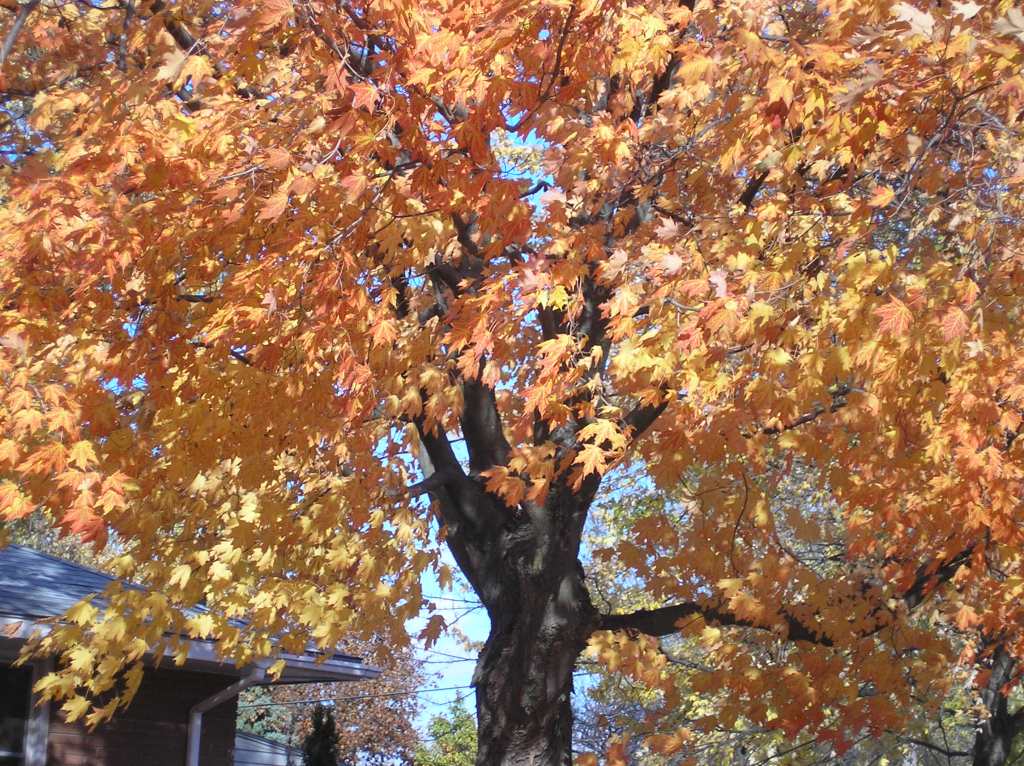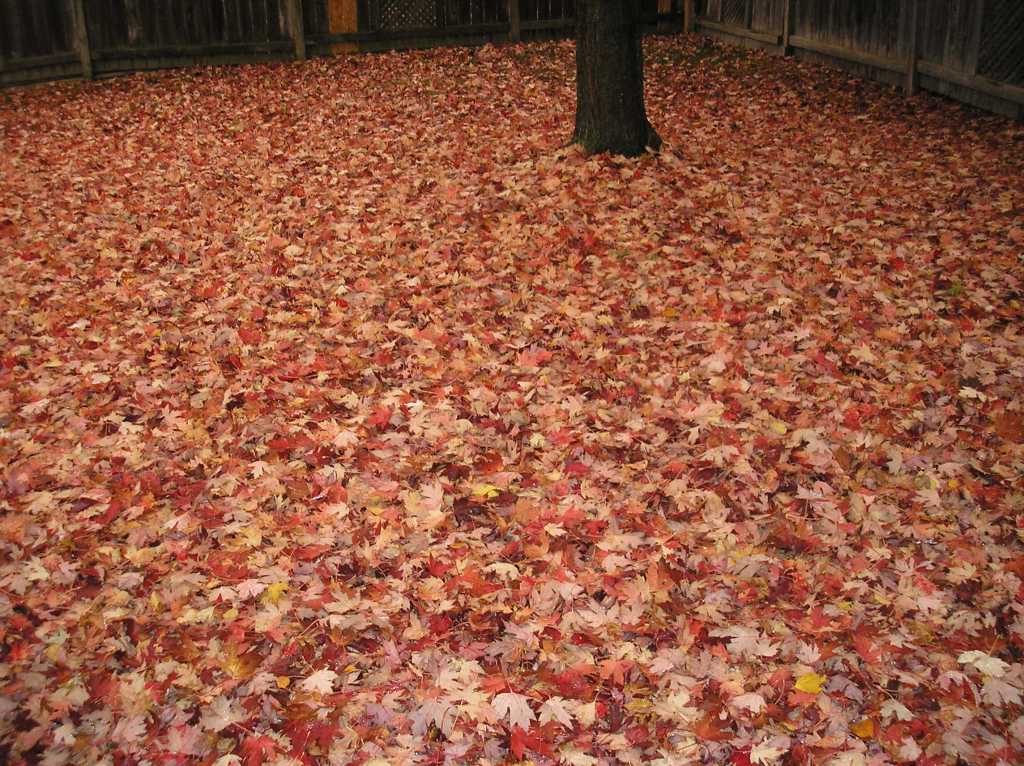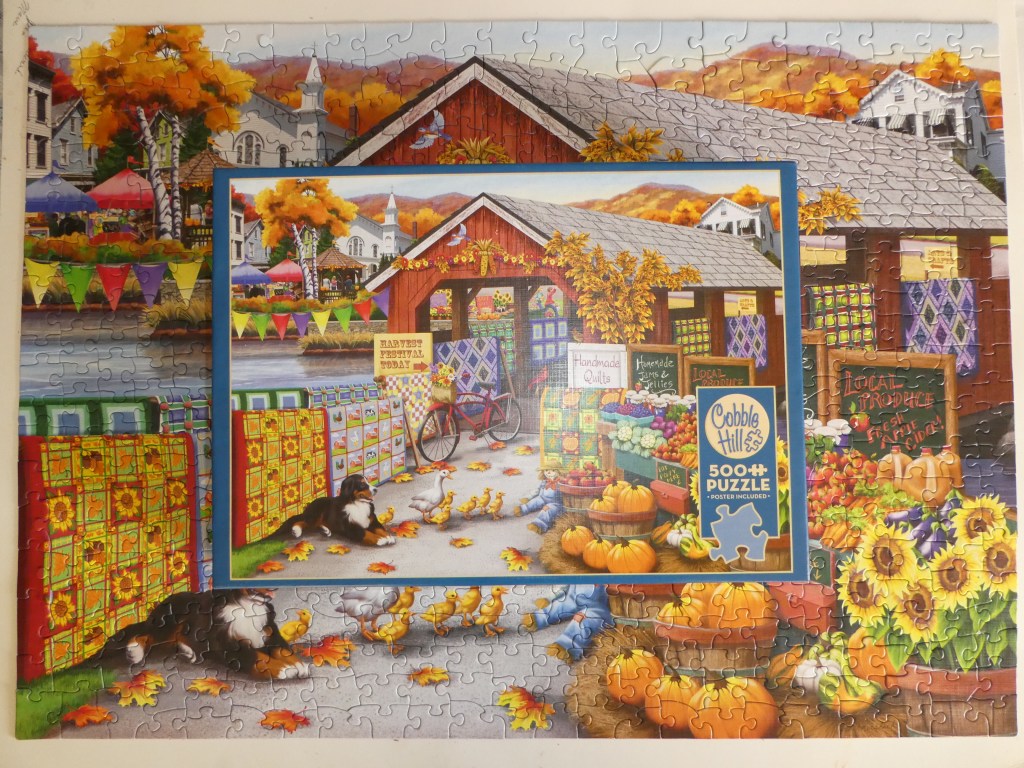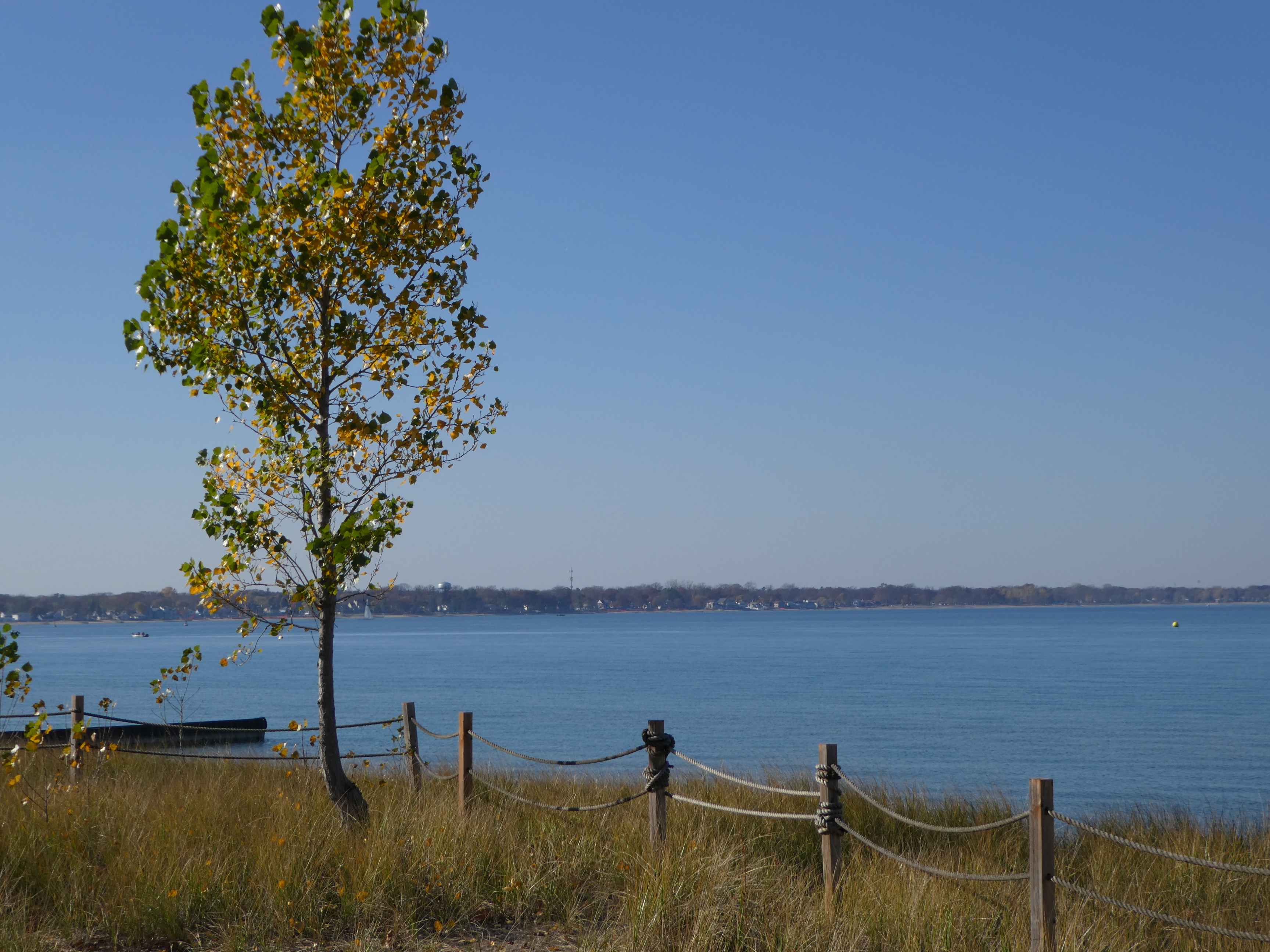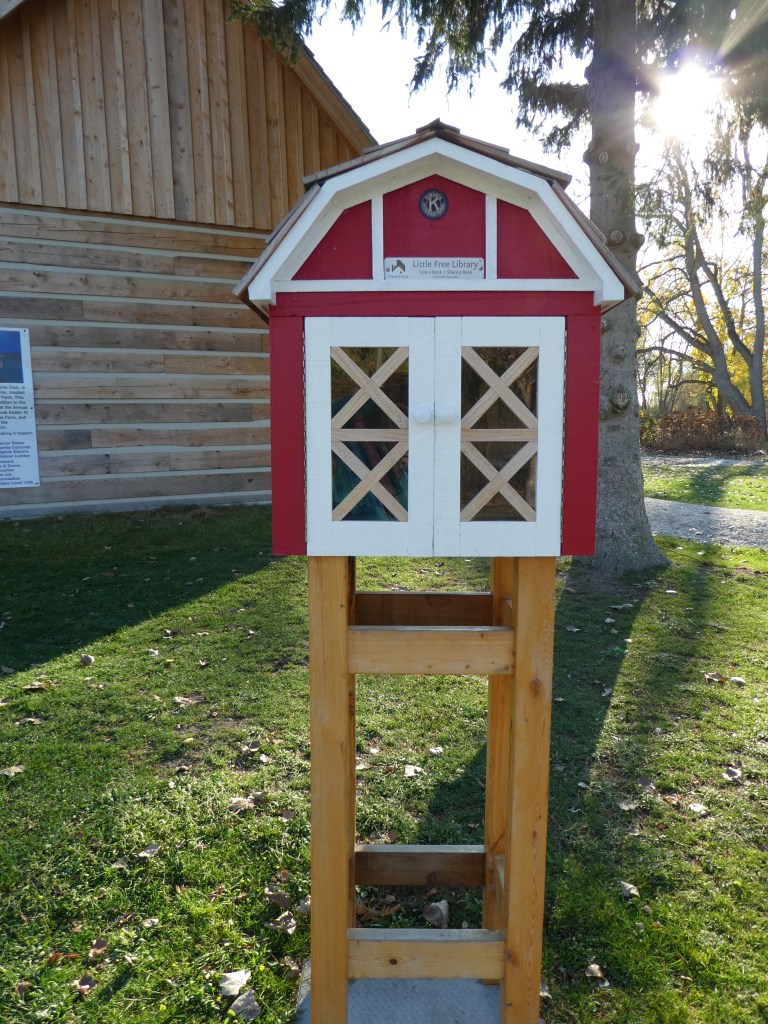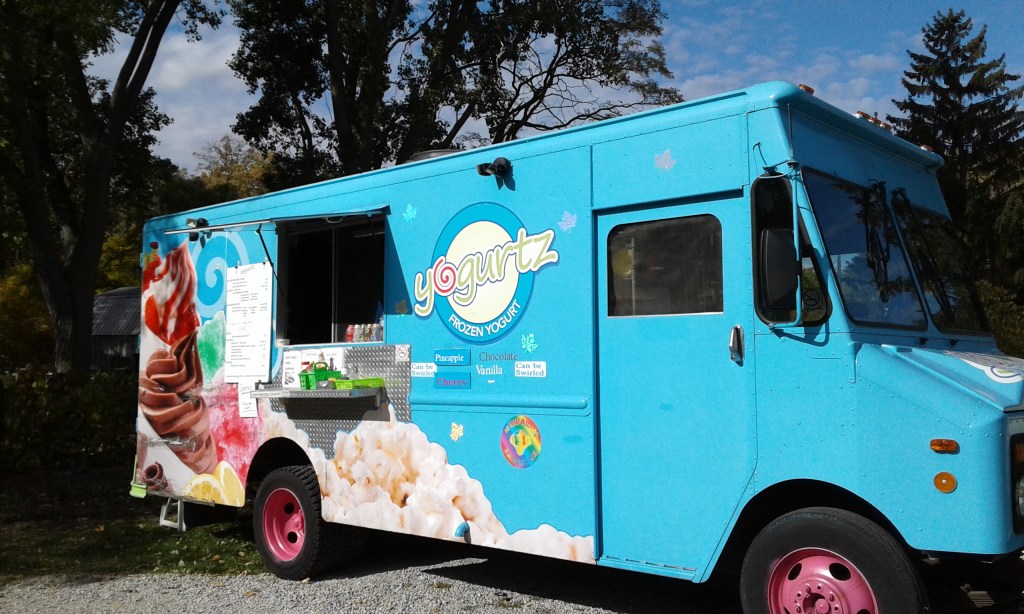



dole, buy hyacinths to feed thy soul.”











For more on the book and movie Enchanted April see link to my 2018 blog here.















For more on the book and movie Enchanted April see link to my 2018 blog here.
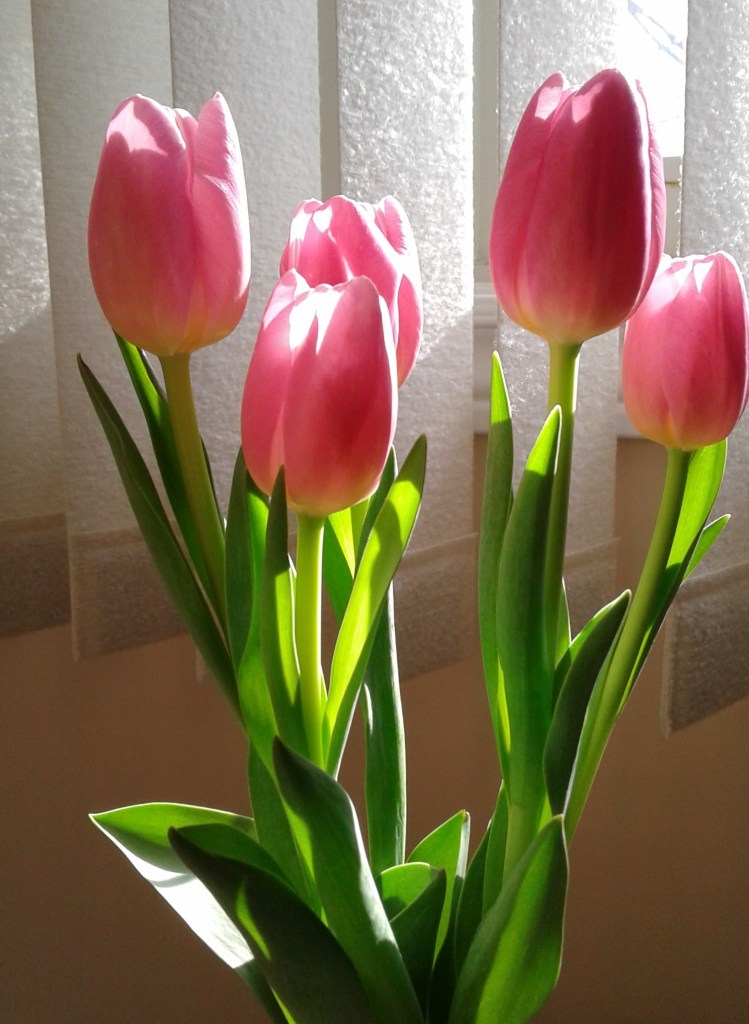






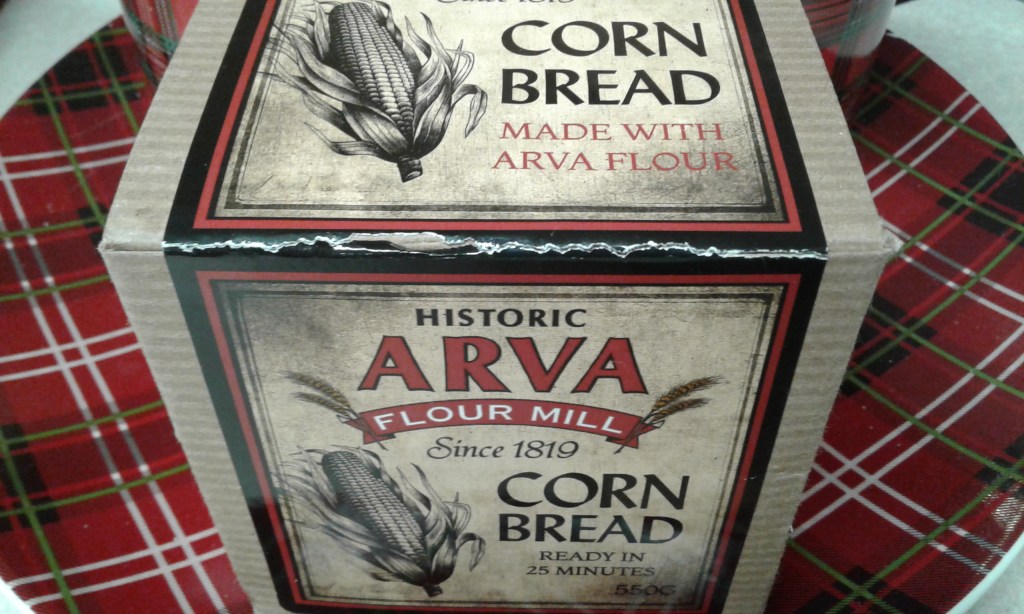
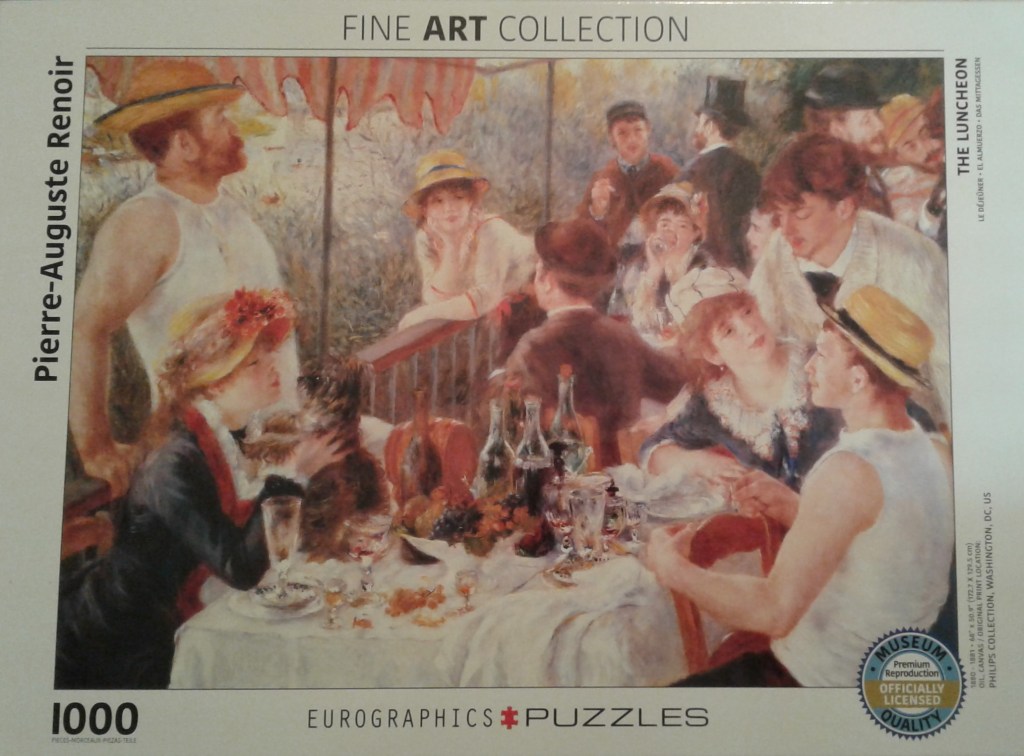

March has been cold and snowy, with no sign of spring in sight. All the better to stay inside when the blustery winds blow and bundle up with a bestseller, especially by one of your favorite authors.
What actually is a bestseller? For years I naively thought a bestseller was a book so good that everyone wanted to read it, and the bestseller list was a compilation of such books, although constantly changing as new ones were published and sales dropped off. But my friend who used to own an independent bookstore and dealt with publishers and reps all the time, tells me it’s strictly a numbers game – bestseller status is based on the number of books ordered period, regardless of whether the book is good or bad, or later remaindered due to poor sales. So if you are a popular author, even if you write a substandard, mediocre book, everyone will order it anyway based on your stellar reputation and profitable track record, although I suppose if you put out enough clunkers your fall from literary grace might be quite rapid.
So lets take a look at six of the best-sellers I’ve read this winter, since I last did a book review in October. These are some of my favorite authors, although not necessarily my favorite books by them. Four are established authors at the top of their game, one is a relative newbie….and then there’s Harry. I’ve noticed that books, like movies, seem to be getting longer. Most of these top 400 pages, thus requiring a substantial time commitment, so read on to see if you’re interested. I’ve also included a peek into the creative inspiration behind some of the books.

Publishers Blurb: For most of the last hundred years, Biloxi was known for its beaches, resorts, and seafood industry. But it had a darker side. It was also notorious for corruption and vice, everything from gambling, prostitution, bootleg liquor, and drugs to contract killings. The vice was controlled by a small cabal of mobsters, many of them rumored to be members of the Dixie Mafia.
Keith Rudy and Hugh Malco grew up in Biloxi in the sixties and were childhood friends, as well as Little League all-stars. But as teenagers, their lives took them in different directions. Keith’s father became a legendary prosecutor, determined to “clean up the Coast.” Hugh’s father became the “Boss” of Biloxi’s criminal underground. Keith went to law school and followed in his father’s footsteps. Hugh preferred the nightlife and worked in his father’s clubs. The two families were headed for a showdown, one that would happen in a courtroom.
My Opinion: This sounded good, even if I didn’t know where Biloxi was (Mississippi), and generally I enjoy John Grisham’s legal thrillers, but at 400 pages, with the first 200 pages just setting the scene of corruption and vice, I seriously thought about abandoning it halfway through. Where were the editors? There’s more about the crime world than anyone would ever care to read. Then when something finally does happen midway, it’s way too sad…..and it gets sadder…..with a poignant although predictable ending. (3 stars out of 5)
A friend of mine, who was a grade two teacher, said she always thinks of her students as that age, full of love and promise, and when she hears of a criminal trajectory to someone’s life, it’s hard to reconcile the bright inquisitive kid she knew with the adult person they ended up being. So many kids are just products of their environment, with little hope of a different life.
John Grisham has written 28 consecutive number-one fiction bestsellers, and his books have sold 300 million copies worldwide. He is one of only three authors to have surpassed 2 million copies on a first printing. (Wikipedia)

Introduction to the Book: Elin Hilderbrand started her writing career writing short stories. In 1990, her senior year at John Hopkins, she had a story called “Misdirection” accepted by Seventeen magazine, which was published in January 1993, for which she was paid the princely sum of 800 dollars. This early boost gave her the belief in herself that she could be a published author. She continued to attend creative writing workshops in NY, at Bread Loaf in Vermont and finally as a graduate of the prestigious University of Iowa creative writing program. She found some success and accumulated at least half a dozen encouraging rejection letters from The New Yorker. She was miserable in Iowa, (she describes the program as very competitive, nearly cutthroat), and missed her family and friends back east and the ocean. The university therapist suggested she start writing about it – so she started her first novel, The Beach Club – set in Nantucket.
Included in this collection are three novellas, short stories and extra chapters that are related but not part of her summer novels. (some were axed by the editors at the time) Three works here have never been published, and the rest only in exclusive editions or in electronic form.
My Opinion: I have a love/hate relationship with Elin Hilderbrand’s books. I swear never to read another one and then every July I end up reading her annual beach book. So it pains me to admit I enjoyed these short stories more than I expected to, and more than some of her books.
There is an introduction to each story first and a pairing to a previous book – she admits the stories will make more sense if you’ve read the original novels. (Is this a clever marketing tool or what?)
But I also have to admit that for some of her earlier pairings, I couldn’t even remember what the book was about let alone the characters in it. Her books are all so similar that the characters often seem interchangeable. For example – The Surfing Lesson (read with Beautiful Day) is a prequel which deals with some of the history between her main character Margot and her husband, two characters I had no absolutely no recall of let alone the storyline. The Tailgate (read with the Matchmaker) Prequel – has a younger Dabney, a student at Harvard attending the Yale-Harvard football game with her boyfriend. Barbie’s Wedding – read with the Rumor – is a sequel involving two of the minor characters in the book getting married. The Country Club – was a prequel to The Identicals set in 1960’s explaining the background of two of the characters who came from different backgrounds. The author mentions that she rented an apartment in the Beacon Hill neighborhood of Boston for six weeks to edit the first draft of that novel, (for maximum concentration, it’s important to be away from home), and was walking and reading about the neighbourhood, and thought she must set a story here someday. Frank Sinatra Drive was a “previously unpublished extra chapter” or alternative ending to The Perfect Couple, which I remember reading but can’t remember the original ending, although I think that was the book with the drowning/murder mystery the night before the wedding weekend and the bride and the best man eloped at the end? But the short story was told from the best man’s POV. She says her inspiration for the story and the name was a vacation in Palm Springs.
The last three were longer novellas. I could recall these more recent books more easily – The Sixth Wedding – read with 28 Summers – if you have not read this downer of a book the main character dies at the end and this novella sequel deals with what happens to her friends and family after her death. She’s written a couple of books like that, one where she killed off the main character in the first chapter. But it’s nice to know life goes on down here on earth for your characters.
The Summer of 79 and Summer of 89 – are novella sequels to her popular novel, Summer of 69. Here she titles the chapters with songs of the decade again. As an 80’s chick you could tell she was having fun with the music, clothes, and popular culture references.
Also fun was a short story called The Workshop – dealing with her week at a summer creative writing workshop in Vermont – the strange characters, the brutal criticism, her constant desire to pack up and go home. Regarding this story, she writes, “This extra chapter has never been published. People often ask what I do when my editor suggests changes or revisions I don’t agree with. The answer is I make them anyway. One edict I have sworn by is my editor is always right. In the first draft of The Golden Girl my main character Vivian attends the U of Iowa Writers Workshop just like I did. I wrote what I though was a vivid (and very funny) chapter where I finally got to describe my experience – the good, the bad and the ugly. I thought the chapter was brilliant. My editor found it distracting and suggested I cut it. I rewrote the chapter into a prequel, changed it to Breadloaf in Vermont and summer of 1995 but the brutal juicy details workshop details remain.”
My editor is always right??? I think I’d be too much of a control freak for that….
Overall, this was a good read. You could tell she enjoyed writing it and it gave me a different perspective on the author’s background and creative process. Also I remember Seventeen Magazine publishing short stories. After all what is a novel but a short story with 400 pages! (4 out of 5 stars)
Elin Hilerbrand has written 34 books. I remember reading her first novel The Beach Club and being impressed with it, probably because I always wanted to visit Nantucket, and then I forgot about her for a decade or two until the librarian recommended one of her books.

Publisher’s Blurb: Olivia McAfee, along with her six year old son, fleas a picture perfect but abusive marriage to a charming heart surgeon with a darker side, and returns to her hometown to take over her deceased father’s beekeeping farm. The book opens with a phone call – her now teenaged son, has been charged with the death of his girlfriend, Lily, the new girl in town. Adamant that he is innocent, she hires her brother as his defense attorney, while also acknowledging that she has seen flashes of his father’s temper in her son and eventually she realizes he’s hidden more than he’s shared with her. Billed as a suspense novel, and an unforgettable love story, and a powerful exploration of the secrets we keep and the risks we take to become ourselves.
My Opinion: This is a return to Jodi Picoult’s regular format – a timely topic and a legal/court case – but’s it’s the first time she’s written a book with someone else. There is a photo of them both on the back which I glanced at but I couldn’t figure out why she would be co-writing, as the prose just seemed like her usual style. She admitted in the acknowledgements that she had been wanting to do a book about this for some time but felt she lacked the expertise to do it justice. (If she had realized that about AI and Egyptian hieroglyphics/archaeology that would have spared us The Book of Two Ways.)
I found the first half of this book a bit draggy, good but not overly so, but when the court case starts and a witness drops a bombshell of a revelation, then it made sense. The chapters are told in alternating POV’s, the mother of the accused teenager, and the girl victim. The victim’s chapters are told in reverse order, with the first being her home sick for the day and opening the door to her murderer, (there are four or five possible suspects) and the last chapter being her move to the new town. It’s an effective and necessary, (to establish the murder as opposed to an accident) although at times confusing method. The mothers POV is more straightforward. I found the last half of the book absolutely mesmerizing, and stayed up way too late several nights to finish it – it’s long at 430 pages.
This novel is bookclub material as there would be lots to discuss. I can’t say more for fear of spoilers, but it was a riveting read, somewhat disturbing but in a thought-provoking way. Let’s just say it would not be to everyone’s taste, but it was certainly educational. (It reminded me of her novel Small Great Things, about the black OB nurse and the white supremacists) (4 stars out of 5)
The author’s notes at the back were interesting to read, especially about how the book came to be. Jennifer Finney Boylan woke from a strange dream in which she was writing a novel with Jodi Picoult – there were three characters in the dream. She went on Twitter and tweeted about it and moments later got a private message from Jodi Picoult, who she had never met, although they had read and admired each other’s work, asking what the book was about. After she gave her a short premise, Jodi wrote in caps, “OMG I LOVE THIS LET’S DO IT.” As Jodi was just starting work on her novel, The Book of Two Ways, it was several years before they could begin work. Jodi also wrote that pandemic novel, Wish You Were Here, as well so she must be a fast writer. They finally started sketching out the plot in the spring of 2020 just as the pandemic hit. Jennifer Finley spent several weeks on the floor with the two stories – Olivia’s and Lily’s, taping them into a storyboard. They agreed that Jodi would write Olivia’s and Jennifer would write Lily’s, but they decided they would each write one chapter from the other’s protagonist POV, but by the time they had edited and re-edited she said she was unable to remember who had written what, although she admits to imitating each other’s style, and it does flow seamlessly. It’s masterfully plotted and written, but as Jodi acknowledged, bound to inspire some hate mail. Note: the apiary/bee facts fits in nicely with the story and there are even some recipes at the end. (Jodi Picoult has written 29 novels.)

Publishers Blurb: It’s a party to end all parties, but not everyone is here to celebrate. On New Year’s Eve, Rhys Lloyd has a house full of guests. His vacation homes on Mirror Lake are a success, and he’s generously invited the village to drink champagne with their wealthy new neighbors. But by midnight, Rhys will be floating dead in the freezing waters of the lake.
On New Year’s Day, Ffion Morgan has a village full of suspects. The tiny community is her home, so the suspects are her neighbors, friends and family—and Ffion has her own secrets to protect. With a lie uncovered at every turn, soon the question isn’t who wanted Rhys dead…but who finally killed him. In a village with this many secrets, murder is just the beginning.
My Opinion:
I loved the jacket blurb, “At midnight one of them is dead, By morning they are all suspects.” Brief and to the point – and doesn’t that just sum up a closed door murder mystery? It takes a special talent to write publishing PR – I know I couldn’t do it.
While I enjoyed this book and her previous psychological thrillers, this wasn’t one my favorites. It’s long at 400 pages and slow at unfolding the motives with different POV’s in different chapters and there are a lot of suspects to keep track of, and some of them have teenage children. So many suspects, that she provides a map at the beginning of who lives in the various chalets at the luxury resort and in the village and along the lake. As well some of the chapters are told in present time and others in flashback. It’s a big and cumbersome plot, and IMO there was a major flaw in the murder method, as the person could easily have killed their own family member. It’s set in Wales where the author lives, but I didn’t get much of an impression of the scenery, other than cold and gloomy. It’s winter and the book opens with a New Years Day “Polar Plunge” swim in the lake where the body is found. (The only other book I’ve read set in Wales was How Green Was My Valley way back in high school.)
The author introduces a new detective, DC Morgan, who partners with a detective from England, as initially they are unsure whose jurisdiction the murder occurred in as the lake is divided between the two countries. There’s even a bit of a love story between them, if you can call a New Years Eve pickup in a bar with aliases in the first chapter, a romance, but after that it’s zero chemistry. I didn’t find either of the detectives very likeable, or interesting, so I’m not sure if I’ll be checking out any of the planned sequels. (3 1/2 out of 5 stars)
Clare MacIntosh has written 8 books, mostly mysteries or psychological thrillers. There was an interesting Q&A at the back of the book, where the author answers the question – “You have an enormous list of plausible suspects throughout the book. When in the writing process do you decide on the final villain?” “The Last Party was really hard to write. My readers are clover and I knew I needed to give them a twisty murder to unpick. The villain actually changed between the lst and 2nd draft because of the way a particular character took shape as I wrote. I find it fun to think about everyone’s motive and love dealing with multiple suspects. I was a police officer for many years and writing a mystery is like investigating a murder in reverse. (page 418)

Publishers Blurb:
In an inspiring follow-up to her critically acclaimed, #1 bestselling memoir Becoming, former First Lady Michelle Obama shares practical wisdom and powerful strategies for staying hopeful and balanced in today’s highly uncertain world.
There may be no tidy solutions or pithy answers to life’s big challenges, but Michelle Obama believes that we can all locate and lean on a set of tools to help us better navigate change and remain steady within flux. In The Light We Carry, she opens a frank and honest dialogue with readers, considering the questions many of us wrestle with: How do we build enduring and honest relationships? How can we discover strength and community inside our differences? What tools do we use to address feelings of self-doubt or helplessness? What do we do when it all starts to feel like too much?
Michelle Obama offers readers a series of fresh stories and insightful reflections on change, challenge, and power, including her belief that when we light up for others, we can illuminate the richness and potential of the world around us, discovering deeper truths and new pathways for progress. Drawing from her experiences as a mother, daughter, spouse, friend, and First Lady, she shares the habits and principles she has developed to successfully adapt to change and overcome various obstacles–the earned wisdom that helps her continue to “become.” She details her most valuable practices, like “starting kind,” “going high,” and assembling a “kitchen table” of trusted friends and mentors. With trademark humor, candor, and compassion, she also explores issues connected to race, gender, and visibility, encouraging readers to work through fear, find strength in community, and live with boldness.
“When we are able to recognize our own light, we become empowered to use it,” writes Michelle Obama. A rewarding blend of powerful stories and profound advice that will ignite conversation, The Light We Carry inspires readers to examine their own lives, identify their sources of gladness, and connect meaningfully in a turbulent world.
My Opinion: Wow, that blurb was a lot to live up to – and it didn’t. I loved her first book Becoming, as it was about her life story, but this was more of an abstract philosophy book, a genre which is not generally to my taste. I’m more of a Tell-Me-A-Story kind of reader, but others might enjoy it though. Billed a a guide to overcoming in uncertain times, I did not find it hopeful/optimistic, (it’s hard to be today), although parts of it were good. I found her comments about children especially insightful, especially what she learned about parenting from Toni Morrison “When a kid walks in the room, your child or anybody else’s child, does your face light up? That’s what they are looking for. When my children used to walk in the room when they were little, I looked at them to see if they’d buckled their trousers, or if their hair was combed, or if their socks were up, she said. You think your affection and your deep love is on display, because you’re caring for them. It’s not. When they see you, they see the critical face. What’s wrong now.” She goes on to say that many of us spend a lifetime registering the presence of critical faces around us and feeling bombarded by judgement and that what Morrison decided to do – dial back the judgement and just be glad to see them, was what her own parents did for her – she was giving them a simple message of enoughness. She was validating their light, that unique bit of brightness inside each of them, and showing them it was there and it belonged to them, a power they could carry for themselves. (3.5 stars out of 5…because it’s Michelle)
Still it was better than Barrack Obama’s 700 page presidential memoir, which I abandoned about 200 pages in (all those primaries) which covered his early political career up until the end of his first term. Wasn’t there supposed to be a sequel about his second term? (It probably doesn’t matter if they got $60 million for the deal.) His 2020 memoir A Promised Land sold 900,000 copies in the first 24hrs, whereas Michelle’s sold 725,000 in the first 24hrs but then went on to sell 10 million copies worldwide, mostly by word of mouth, thus illustrating my definition of a bestseller.

And then there’s Harry….
This was definitely a bestseller, although his latest PR event – $60 for a copy of the book and the privilege of a watching an exclusive interview – might indicate that sales didn’t quite meet expectations. (I borrowed mine from the library.) It’s divided into three sections, his early life after his mother’s death, his army life, and his life after meeting Meghan. The book was reputed to have been written by a celebrity ghostwriter, as Harry himself admits he had difficulty in school sitting and reading a book. I suspect he probably dictated it. In the opening chapter he is walking around the gardens with William and Charles after Prince Phillips funeral, and they just don’t understand why he left – so he felt he needed to write the book to explain it to them….(in 400 pages). I found the overall tone of the book way too melodramatic, but it was a fascinating read, although not for the reasons that Harry might wish. He’s obviously a damaged soul, so I’ll spare you the four pages of notes that I made after I finished. It’s definitely bookclub material, but it just made me feel sad for all of them.
Have you read any bestsellers lately?

Cherry Cheesecake is a classic Valentine’s Day dessert. It’s red so it fits the color theme of the day. It’s rich and decadent. And lastly, you can justify the calories as it’s Valentine’s Day which only comes once a year.
I know that fancy flavored cheesecakes like salted caramel chocolate-pecan or pumpkin spice are more popular now, but you can buy those ready-made or order them in a restaurant if you want to try a piece. For real cheesecake I prefer the no-bake variety, from a recipe I inherited from my mother in the eighties – it’s quick, easy and delicious, not to mention rich and creamy. I find many baked cheesecakes tend to be on the dry side. I think the recipe originated on the side of the Philadelphia cream cheese box. My mother often made this as an Easter dessert but one year she bought the onion-flavored cream cheese by mistake, and my SIL took the first bite and said, well this certainly tastes different! Needless to say, the rest of it went in the garbage. For a crowd, she would double the ingredients and make it in a long 9X13 glass pan, so it was quite a waste.
So, let’s travel back to the decade when hair was big, shoulder pads were bigger, music was loud and cholesterol didn’t exist. You can throw this cheesecake together in five minutes, because as an Eighties Chick you have more important things to do, like listen to rock and roll! (Musical interlude – insert your 80’s song of choice here)
The ingredients:

One 6oz. round ready-made graham cracker pie crust (unless you prefer to make your own and/or have a heart shaped pan).
1 can (14 oz – 420ml) sweetened condensed milk (Do not confuse with evaporated milk – Canadian cans are 300ml so I had to buy two cans and waste half)
1 package (8 oz – 250g) Philadelphia cream cheese (softened at room temperature)
1/3 cup lemon juice – bottled or fresh (or to taste. When I googled this old recipe there were some complaints about 1/3 cup being too much and making it too runny, some people used 1/4 cup (60ml) or even less, so I started at 30ml and adjusted to taste using about 60ml total, but I think I could have used the 80ml. My lemon juice was a mixture of water, lemon juice and lemon oil. You have to add some lemon juice to cut the sweetness.)
1 teaspoon vanilla extract
1 can (21 oz – 540ml ) cherry pie filling (I like E.D. Smith brand, the Regular one not the or Light and Fruity which has 1/3 less sugar and calories but a tarter taste. I wouldn’t want to calculate the overall calorie count and saturated fat percentage for this dessert as in the 80’s we didn’t worry about those things. A night of dancing would wear that off in no time.)
The Directions:
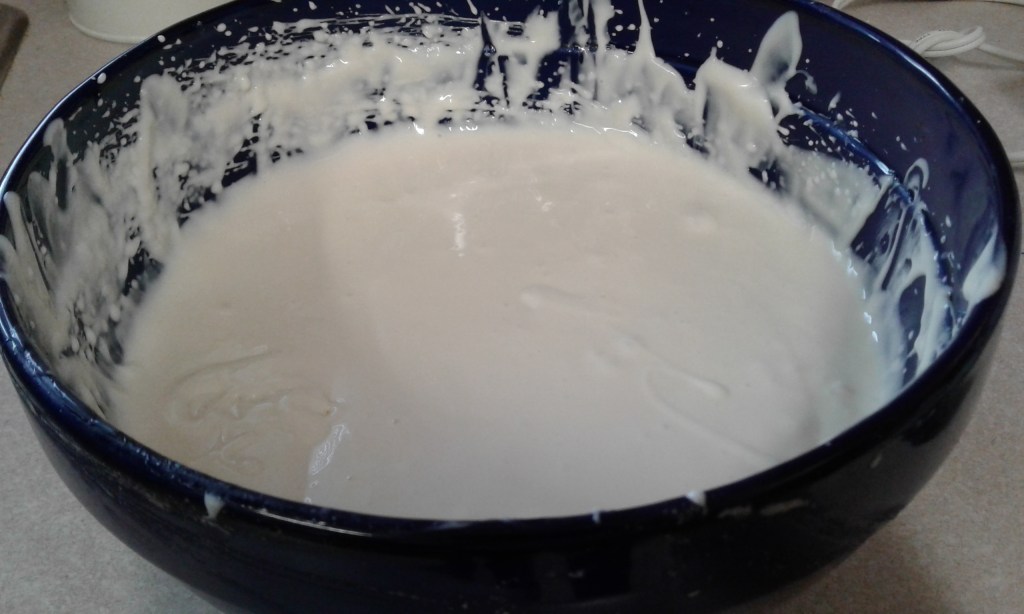
In a medium bowl, beat cream cheese until light and fluffy.
Beat in sweetened condensed milk.
Add lemon juice and vanilla and stir until well mixed.
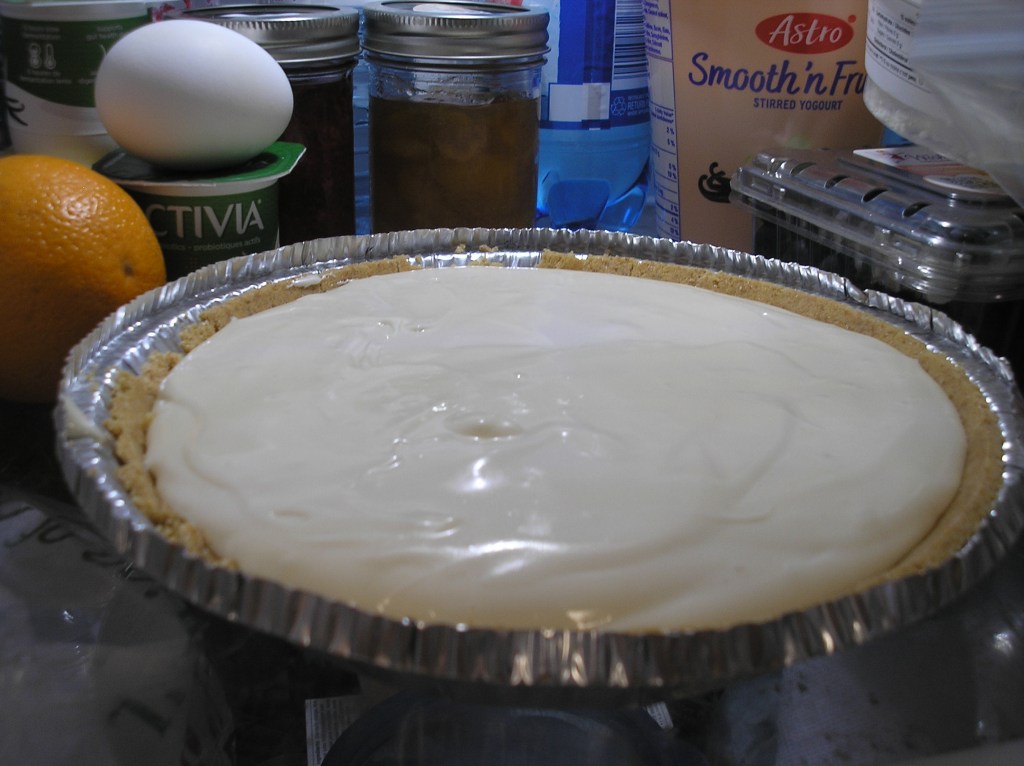
Pour filling into crust and chill for 2-3 hours – it will be softer than a baked cheesecake.

Top with cherry pie filling. I often don’t do this until a few hours before serving, to make sure the mixture has set properly. Really the whole thing is better made the day before to allow the flavours to blend.

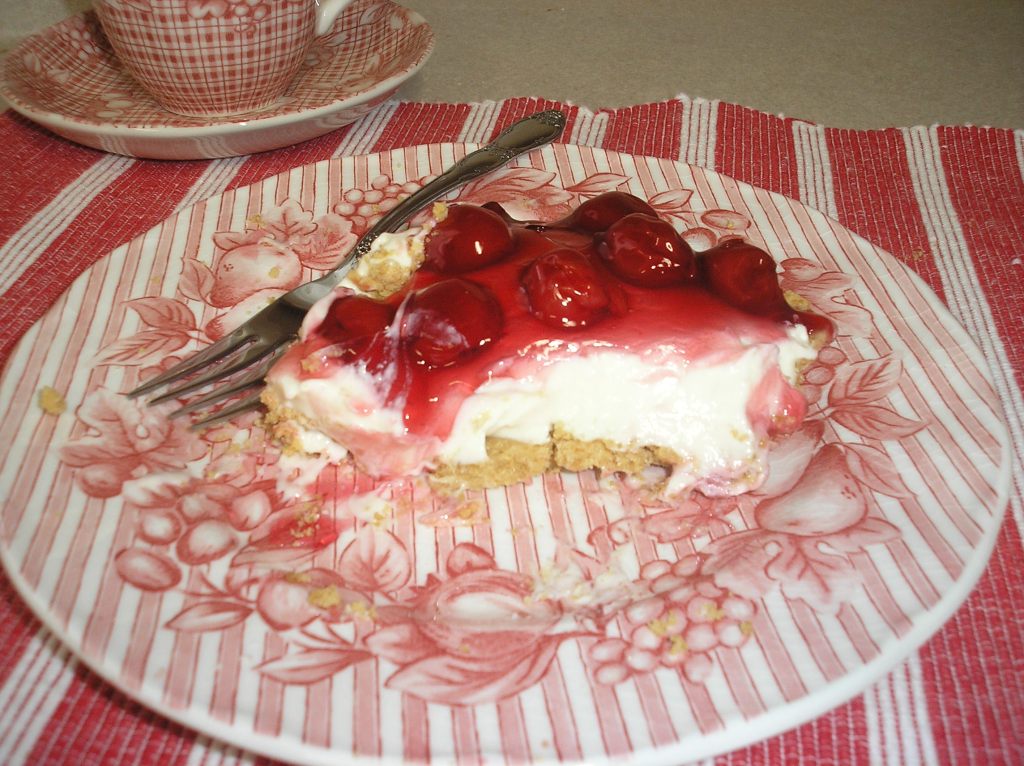
I made this for a Harvest Tea several years ago pre-pandemic and the Group of Six art ladies really enjoyed it.


Happy Valentine’s Day!














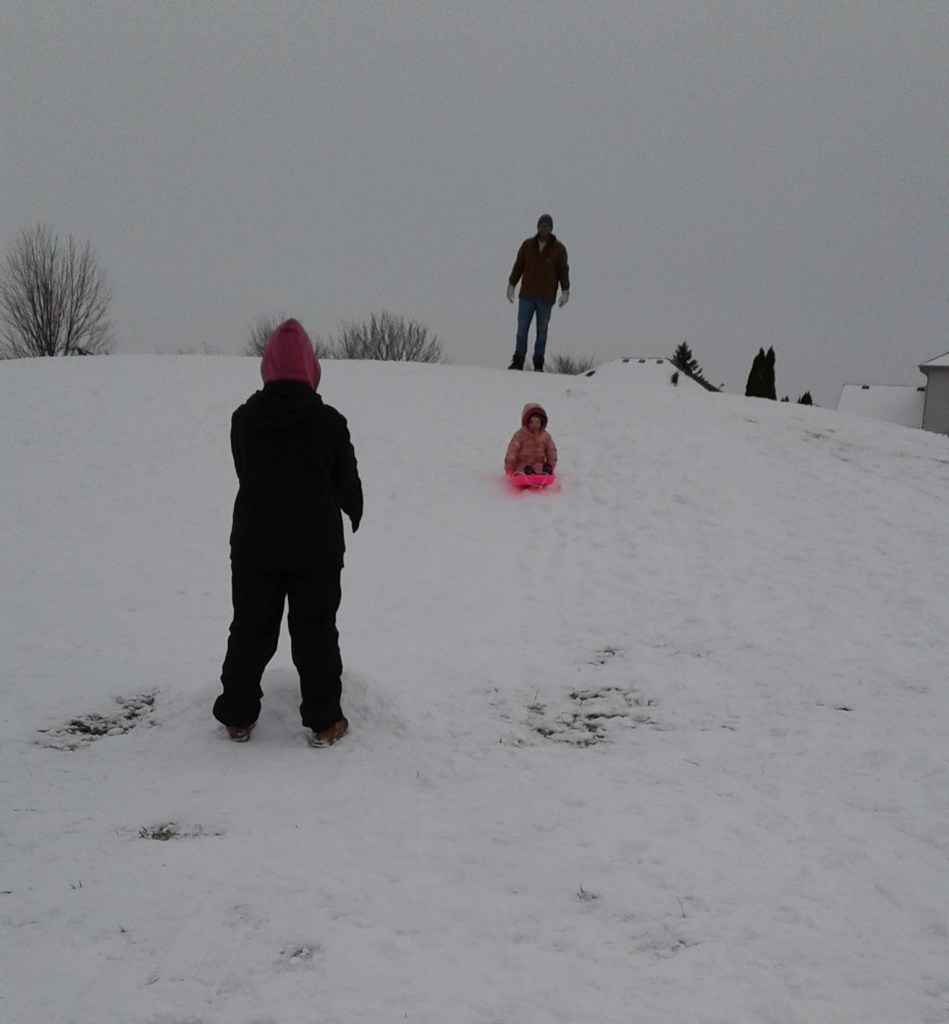

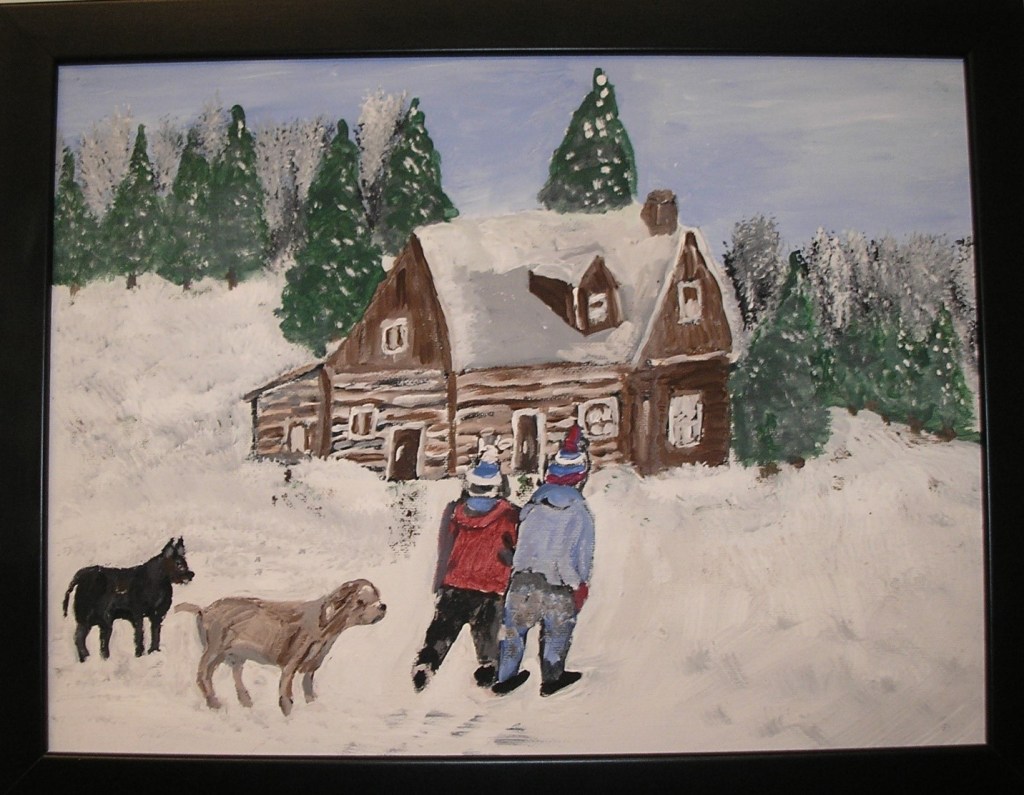

Usually I don’t mind January even if it is cold, dark and dreary. It’s a quiet month, a welcome respite after the rush of the holidays and a perfect time for quiet reflection or creative projects. But as we start year four of the COVID pandemic, (yes, hard to believe), along with flu, RSV and those nasty Christmas colds still circulating – well, it’s hard not to resent being stuck inside once again. For some inspiration on how to turn a bad attitude into gratitude (so cozy to be cocooning among the comforts of home), I turned to Danish author, Meik Viking’s latest addition to his growing list of hygge/happiness books.

Here’s the publishers blurb:
The author of the New York Times bestseller The Little Book of Hygge, helps you turn your home into your happy, cozy safe place.
The urge to nest and control our close environments has never been stronger. We spend more time in our homes than anywhere else—but the way in which our homes impact how we feel has remained relatively unexplored until now.
Backed with Danish design principles, years of research, case studies and a sprinkle of hygge, Meik Wiking has created the ultimate guide to turning your home, office, or wherever you may be, into your happy place.
The Hygge Home will teach us all how to create a much-needed cozy safe space in our homes into which we can retreat to escape the tough things going on in the outside world. Meik will explore the size of our spaces, the way we decorate our homes, the amount of natural light coming in, how much access to green space we have and how we can extend these design principles from inside our homes to our neighbourhoods and beyond. Meik is guaranteed to help you create a home and safe space where you can both live and thrive.
Discussion:
If you have read his previous books, The Little Book of Hygge or The Little Book of Lykke, (Denmark is home to the world’s happiest people and the author is the CEO of the Happiness Institute) this is basically the same book, although much larger in dimensions (9X11) but with the same small print. There are plenty of pretty pictures of fireplaces scenes and cocoa…
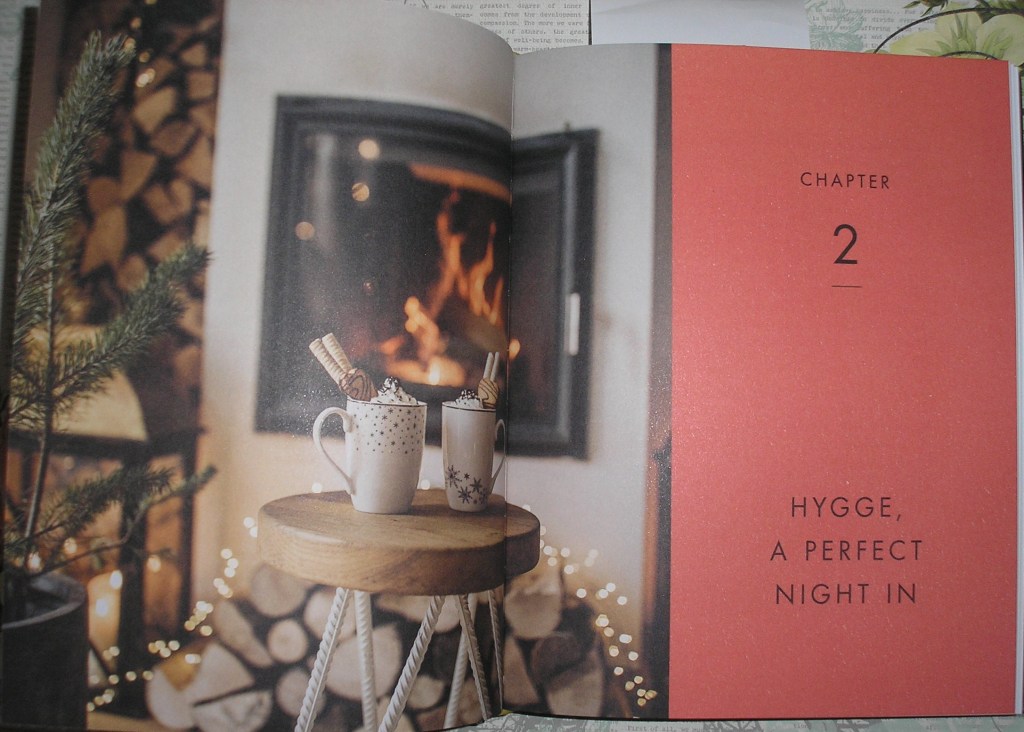
….and advice about cooking and stocking your pantry. “A well stocked pantry is comforting….if there is an abundance of food, mankind would preserve it from earliest times.” Of course stockpiling provisions for the winter was always a matter of survival for our ancestors, so when my relatives reported those 10 bushels of apples on the 1861 census they were also preventing scurvy as there was no fresh fruit available at the general store. “No matter what is going on if there is something to eat at home and a well-stocked pantry, fridge or kitchen cupboard, there is a fail-safe way to hygge hunker down during events beyond our control, whether it is a blizzard or a global pandemic.”
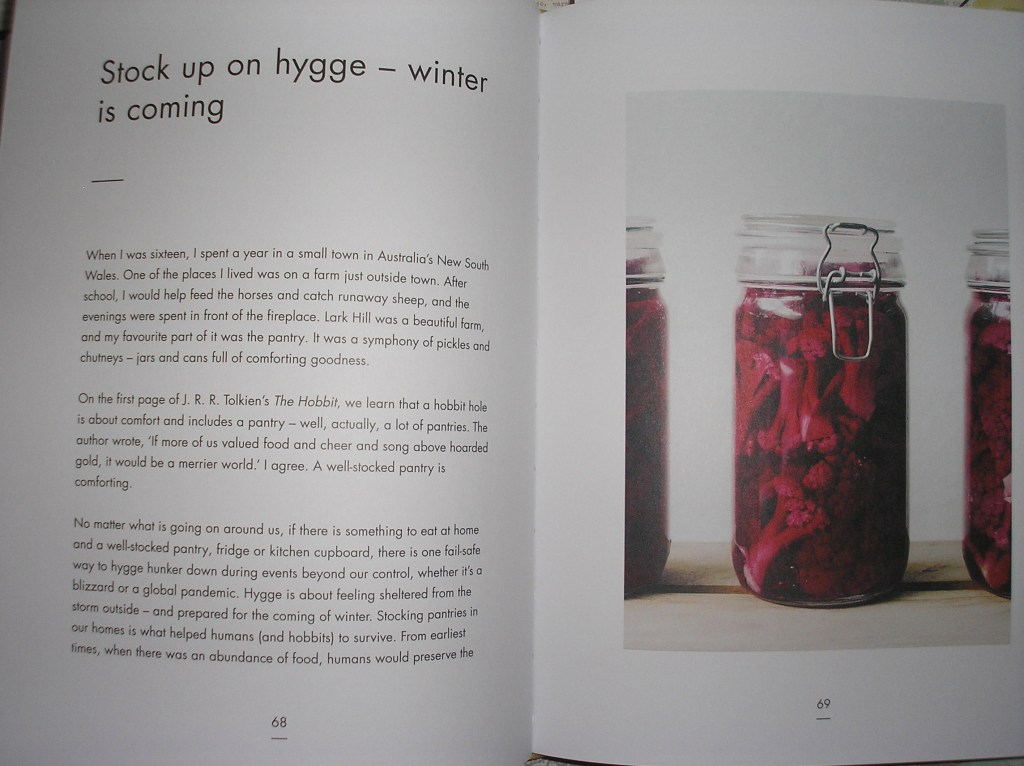
There is a section on pre-cluttering – a term I had not heard before, but he says stop and think before you buy that pancake batter dispenser. Does anyone really need a pancake batter dispenser – no but I’m tempted, it sounds like a handy thing if you make pancakes.
There are also readers stories, like the man who wrote and said what a difference lighting a candelabra at supper had made to his family’s dinner table conversation, no more teenagers shoveling food in and then disappearing back to the company of their electronic devices, plus it saves on hydro too. (This is so true, walk into any candle-lit restaurant and don’t you feel an instant sense of calm descend…..until you see the bill.)
There are anecdotes, like Cezanne designing his studio in the south of France for the best possible painting conditions, and the author’s own search for a writing room of his own. I envy him his walnut desk which he bought with his first royalty cheque. I myself would love to find “a desk that begs you to sit down and write,” although I’m usually okay once I get started.
Overall, there was less about what constitutes hygee (book one) or happiness (book two) here, and more about lighting, design, workplaces, green spaces and city planning etc – he is Danish after all and so many people have been working from home…..and hope to stay there.
I suppose if you have great literary success with a unique formula you can just keep re-inventing it and readers will continue to buy it. Although it was somewhat repetitive, I did enjoy this book because it was fun and sometimes you just need a light comforting read. Plus it made me feel better about hibernating indoors.
What else helped? (or applying the principles)
The weather has been mild and above freezing most days with little to no snow, other than that mini-blizzard at Christmas – very strange weather for January, but good for walking, if you don’t mind walking in the misty rain. It hasn’t been very hygge though – hygge requires the contrast between coming in from the bitter cold to a warm and comforting environment.

Almost a month into winter, and the most snow we’ve seen has been on my mother’s puzzle.
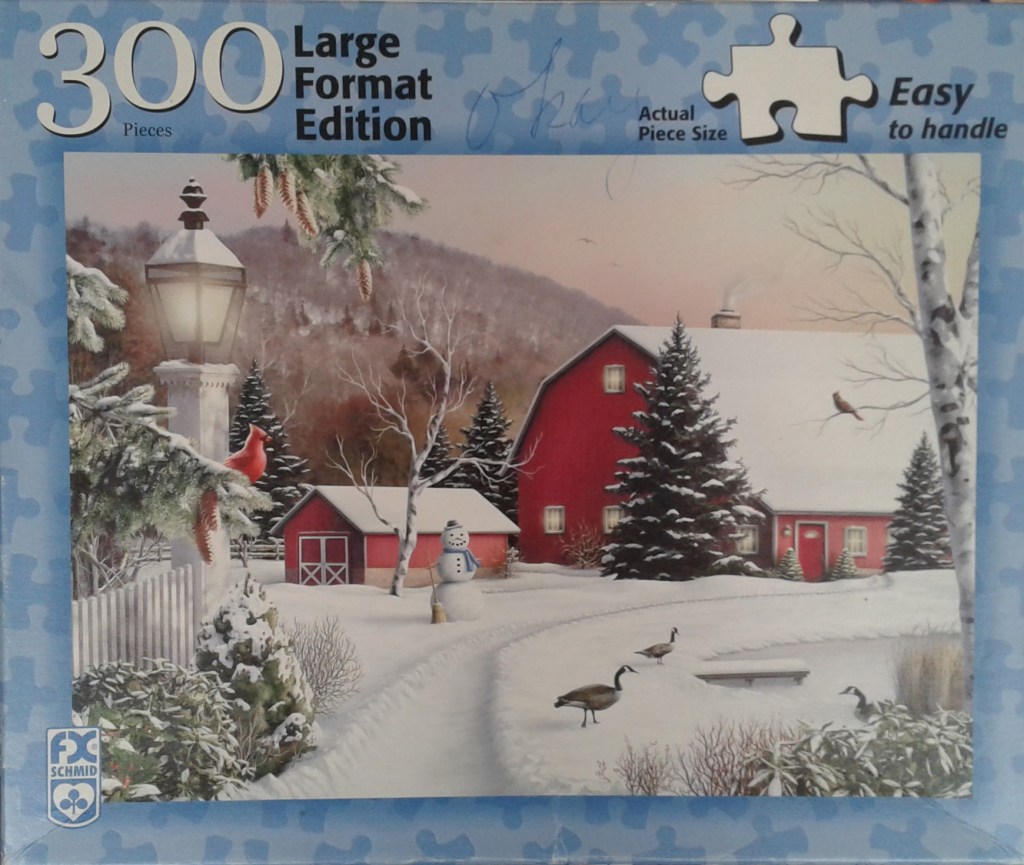
I haven’t worn my down-filled parka even once as…..

the only thing chili has been in a pot.


There have been plenty of books, (reviews to follow sometime) including this one which I’m just starting. The 86 yr old Swedish author, Margareta Magnusson, wrote The Gentle Art of Swedish Death Cleaning – a bestseller several years ago, the gist of which was don’t leave a mess for your heirs to clean up. (That’s fine but how do you know when you’re going to die – you might live another ten years and wouldn’t you want your treasures around you until then? Where’s the hygge in that?) She must have decluttered the book, as it’s a very slim 130 pages, more of a memoir really than a decluttering guide, although there is an appendix chapter at the end. I seem to have zero interest in cleaning and reorganizing this January – the maids cancelled again and I just don’t care – let the dust and the glitter from the Christmas decorations reign supreme.
There was a batch of brownies – the kind with lots of icing – always comforting on a bleak winter’s day.

And if all else fails, there’s always pie…..channeling my ancestors again.

Happy January – from my hygge home to yours! Two more months until spring….yea…..






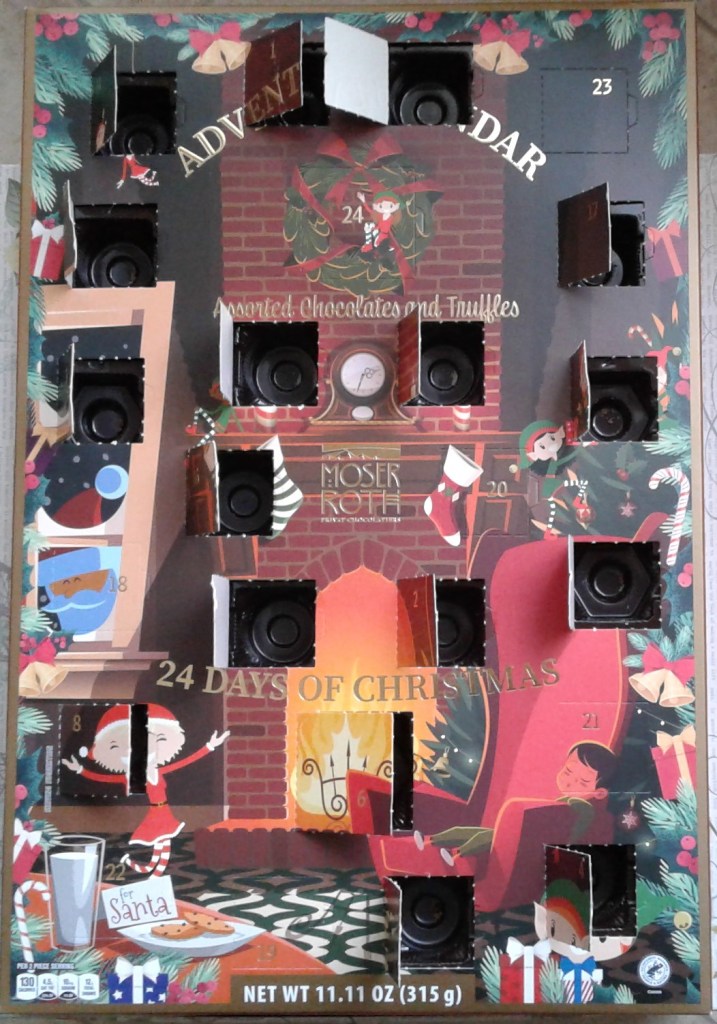

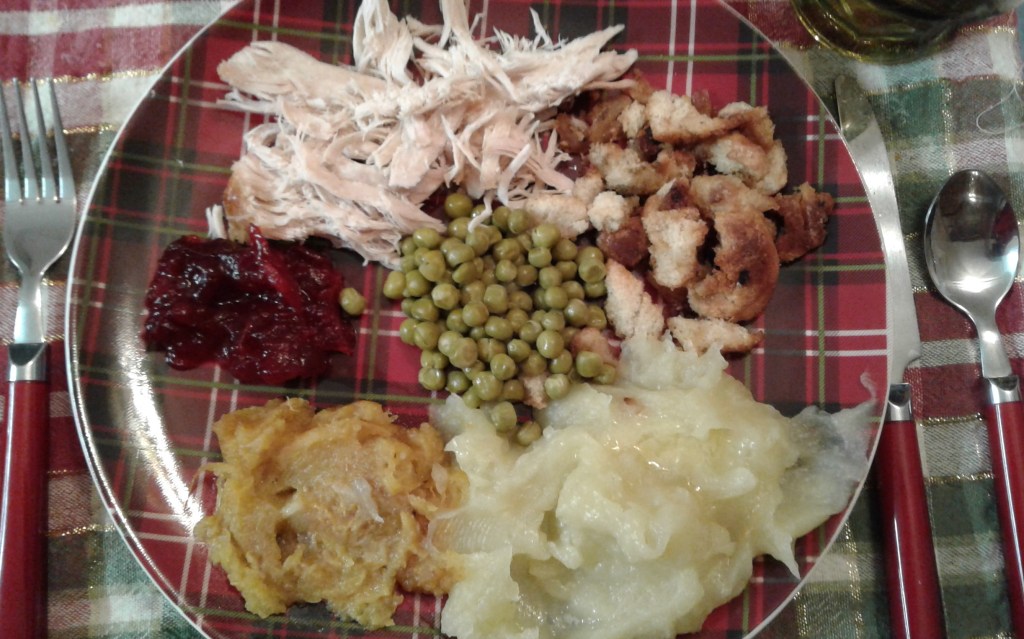


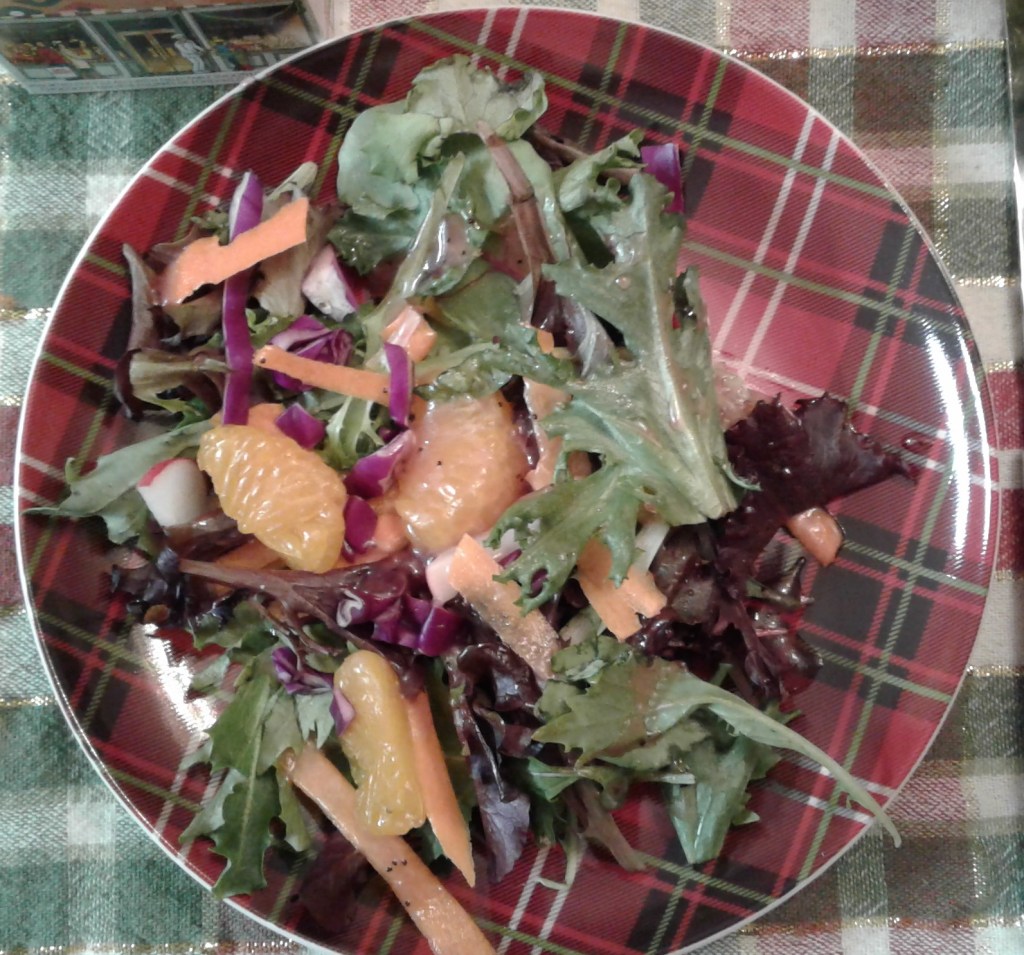







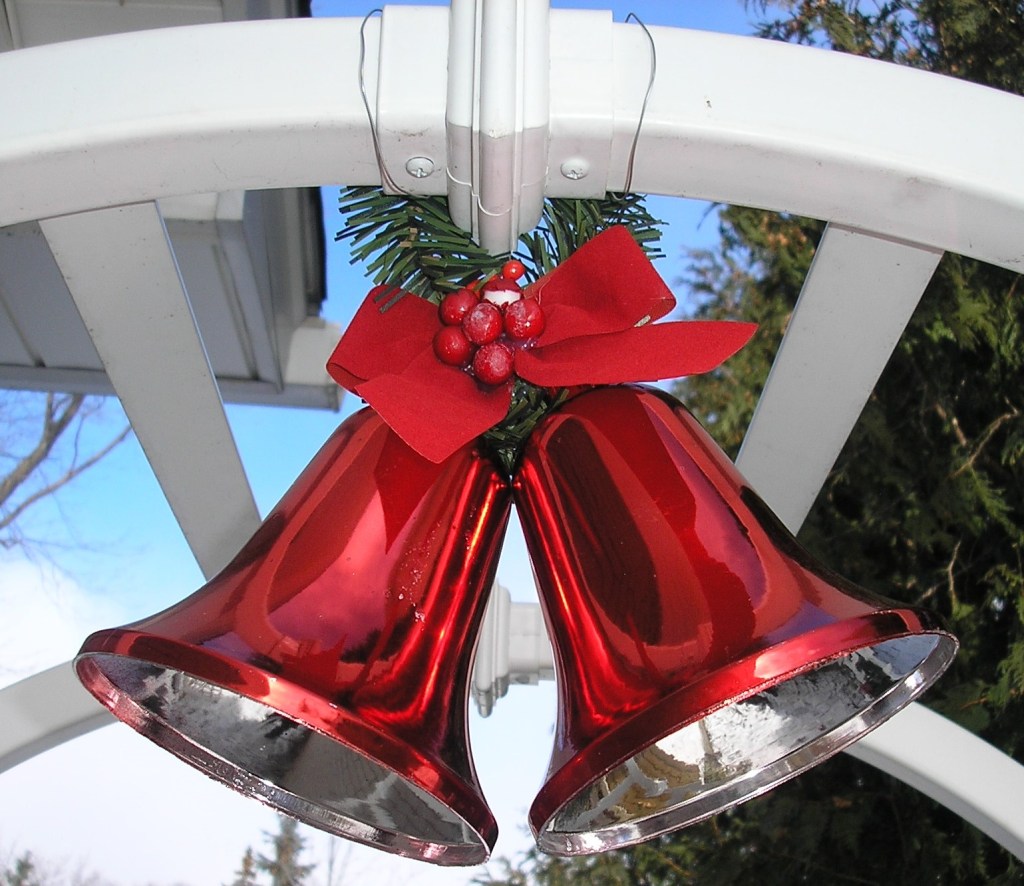

There are three kinds of people – those who love Christmas cake, those who hate it and those who just want a piece or two, preferably made by someone else. Count me in the later category. Christmas cake was a staple of the season for decades but is now one of those Dickensian desserts which have fallen out of favor, along with mince pie and plum pudding, with many younger people not being familiar with any of them.
My mother used to make Christmas cake every year – one big round pan and two or three smaller loaf tins, and it all got eaten, but by whom I don’t know. Certainly, none of us kids ate it. My dad was fond of it, as was my grandmother, who also made her own, a single round one. Perhaps some of it was given away? It was always passed around on the same gold glass platter after the big turkey dinner, with a few cookies on the side, as everyone was much too full for a regular dessert. It was something to nibble on with a cup of coffee or tea. I also have a memory of my dad enjoying a slice of it on Christmas Eve with a glass of port, while watching midnight mass or A Christmas Carol, and sometimes I would join him. The port was an old family tradition, as he seldom drank and a bottle would last from year to year. Port, which also heralded from Dickens day, is a type of fortified wine like brandy and strong stuff if you’re not used to it.
Christmas cake is a dark fruit cake often made a couple of weeks before Christmas, and tightly wrapped, to give it a chance to age. A friend adds brandy to hers once a week to keep it moist. My grandmother added cocoa to hers to make it darker. It seems every family had a different recipe. As it keeps well, it was traditionally a popular choice for wedding cake. At peek at my mother’s 1945 cooking bible, The Purity Cookbook, has two recipes for dark fruit cake, one for Wedding Cake calling for 12 eggs and 3 and a ½ cups of flour and 8 assorted sized pans, and one for six loaf pans requiring 10 eggs and 8 cups of flour. My mother’s recipe called for 8 eggs, and made one round bundt cake and 2 or 3 loaf tins.
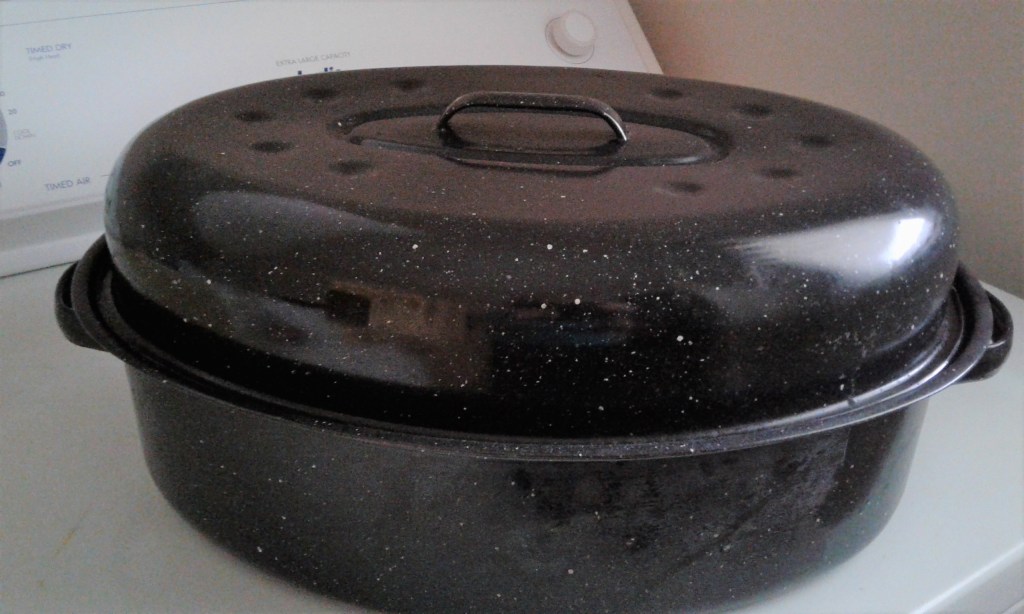
In mid-December out would come the big turkey roaster, as it was the only thing large enough to mix all the ingredients in. She would usually make it in the evening after supper was done, when I could help if I was home, and my dad would be in charge of adding the rum – “Maybe a bit more” although it’s debatable whether one splash or two would make much difference with so much batter.
Here’s her recipe….sort of….as we last made it five years ago and I wrote the instructions down afterwards in an effort to have something on paper. Like many experienced cooks, her measurements were not exact, but it always turned out good. I believe we froze some of it for the following year, as it freezes well (if you’ve ever found a piece of wedding cake stashed away sometimes the cake lasts longer than the marriage) and gave some away to a snow-shoveling neighbour and a couple of her art friends. It’s always best to ask first if you don’t know what category people are in (see intro) as you don’t want to subject someone to an annual gift of something they have to pretend to like.


So because I had a craving for it this year, (that store bought stuff is dreadful – see song) I decided to attempt a small loaf tin, using the recipe for my Date and Nut Loaf as a starter, (see link), as it is basically a foolproof recipe. I made a rare visit to the Bulk Barn store for the mixed dried fruit as the packages available in the grocery store were almost expired and had papayas (?) in it instead of dried pineapple. I hate those bulk food places – the germs – everyone handling the same utensils – but I sanitized before and after, and tried to avoid the green pieces in the mixed fruit bin as those were the ones I always used to pick out of the cake. I also bought currants there, as what would I do with a whole bag of currents, although I put some raisins in too. (NB: the pioneers never had access to raisins/dried grapes, hence the preponderance of currents in those old recipes.) Total cost about $6, although it could have used a bit more fruit.
Here are the ingredients.



I mixed 2 tablespoons of butter, ¾ cup of sugar, one egg, one teaspoon of vanilla. Added ¾ cup of water to the currant/mixed fruit mixture, (but you could substitute milk or OJ) and a splash of rum – (15ml/1/2 ounce) and added 1 ¾ cups of flour (the kind with baking soda and salt already in it). Plus a smidgen of spices – cinnamon, nutmeg, allspice. The only thing I forgot was the dates, as I didn’t have any, but in retrospect the stewed dates/water mixture would have made it a darker color, as it turned out much too pale, not fruit-cake color at all. I added the walnuts after I had prepared a cute little mini-loaf for a friend who reminded me how much she loves fruit cake but is allergic to walnuts. Baked at 350 for about an hour.


It came out more like a tea bread than a traditional Christmas Cake.
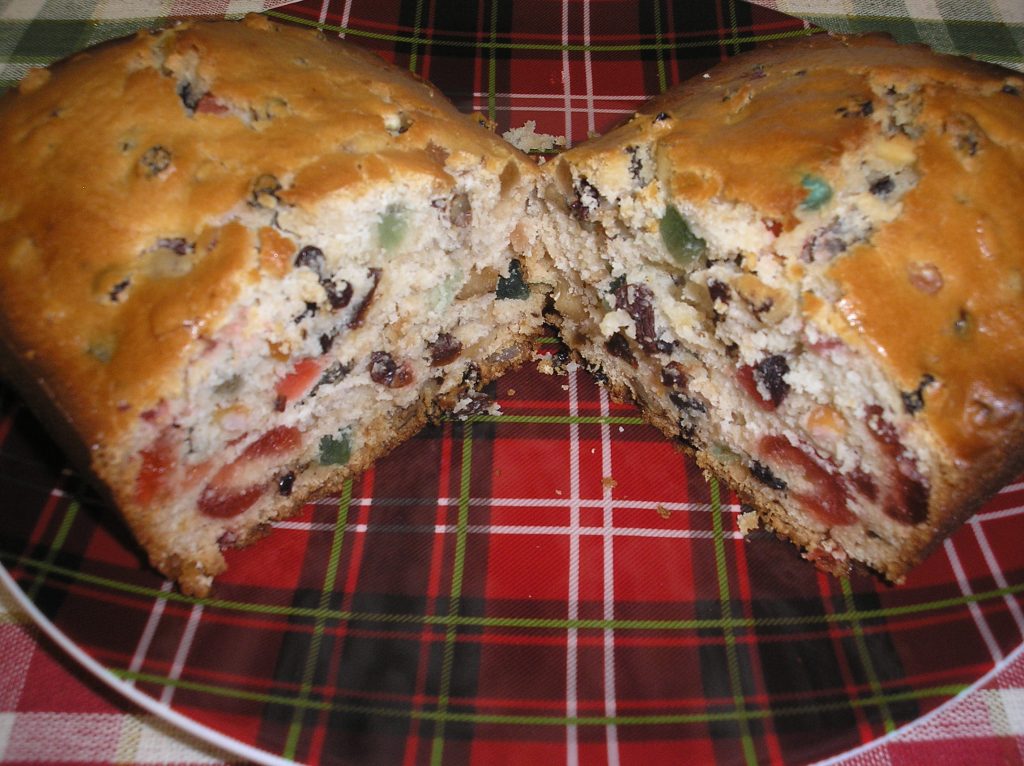
It tasted okay – a bit sweeter than I liked but next time I would definitely add the dates for color, plus more spices, more fruit, less flour and cut back on the sugar a bit. Overall, for a true Christmas cake it needs more work but I would make this again as is for a nice treat with Christmas morning coffee. Maybe this will be the start of a new Christmas tradition!
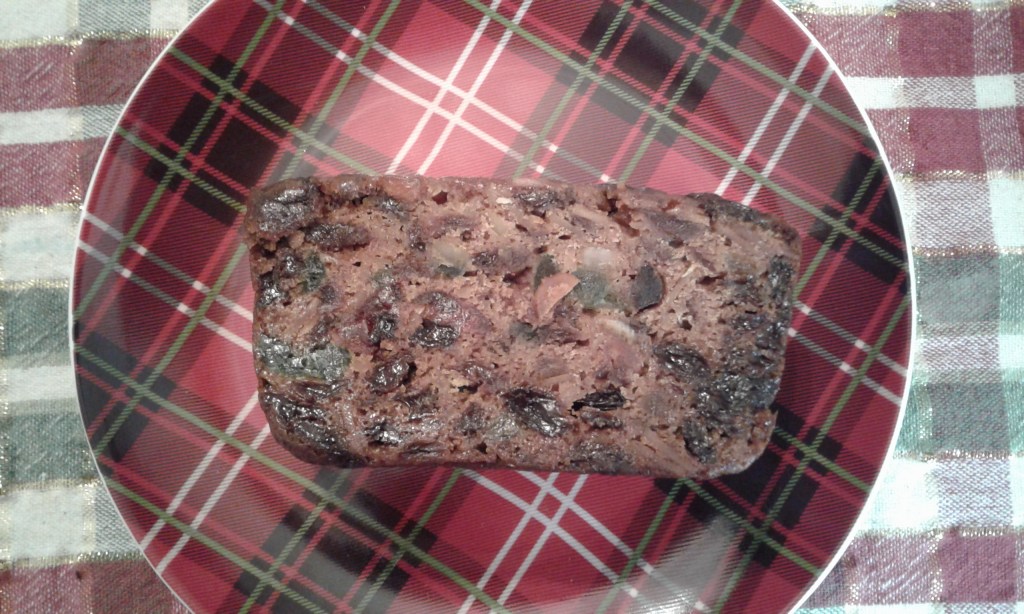
In the meantime a neighbour gifted me a chunk of her more traditional cake, which satisfied my craving.

And now for the silly song – Miss Fogarty’s Christmas Cake – by the Irish Rovers. This was part of the song set of a play I saw last September and was very funny with the animated actions of the actors and Miss Fogarty of course. It’s by the Irish Rovers and the lyrics sum up what Christmas Cake haters think about Christmas cake! Hope you enjoy it!
Miss Fogarty’s Christmas Cake – lyrics
As I sat in my window last evening
A letter was brought round to me
A little gilt-edged invitation sayin’
“Gilhooley come over to tea”
Each Christmas the Fogarties sent it
So I went just for old friendships sake
And the first thing they gave me to tackle
Was a slice of Miss Fogarty’s cake
Chorus:
And there were plums and prunes and cherries
There were citrons and raisins and cinnamon too
There was nuts and cloves and berries
And a crust that was nailed on with glue
There were caraway seeds in abundance
Sure if I’d work up a fine stomach ache
That would kill a man twice after eating a slice
Of Miss Fogarty’s Christmas cake.
Miss Mulligan wanted to try it
But really it wasn’t no use
For we worked on it over an hour
But a piece of it wouldn’t come loose
Till Halley came in with the hatchet
And Murphy came in with the saw
But Miss Fogarty’s cake had the power
For to paralyze any man’s jaws
Chorus:
Miss Fogarty proud as a peacock
Kept smiling and talking away
Till she tripped over Flanagans brogans
And spilt the potcheen in her tea
Aye Gilhooley she says you’re not eatin
Try a little bit more of me cake
“Oh no Mrs Fogarty” said I
Any more and me stomach would break
Chorus:
Maloney was sick with the colic
O’Donnell a pain in his head
McNulty lay down on the sofa
And he swore that he wished he was dead
Miss Bailey went into hysterics
And there she did wriggle and shake
And all of us swore we were poisoned
From eating Miss Fogarty’s cake
Chorus:
And there were plums and prunes and cherries
There were citrons and raisins and cinnamon too
There was nuts and cloves and berries
And a crust that was nailed on with glue
There were caraway seeds in abundance
Sure if I’d work up a fine stomach ache
That would kill a man twice after eating a slice
Of Miss Fogarty’s Christmas cake
Yes it would kill a man twice after eating a slice
Of Miss Fogarty’s Christmas cake





